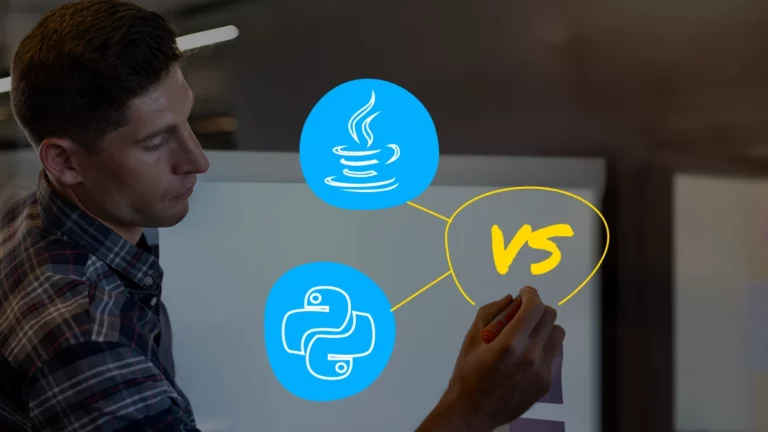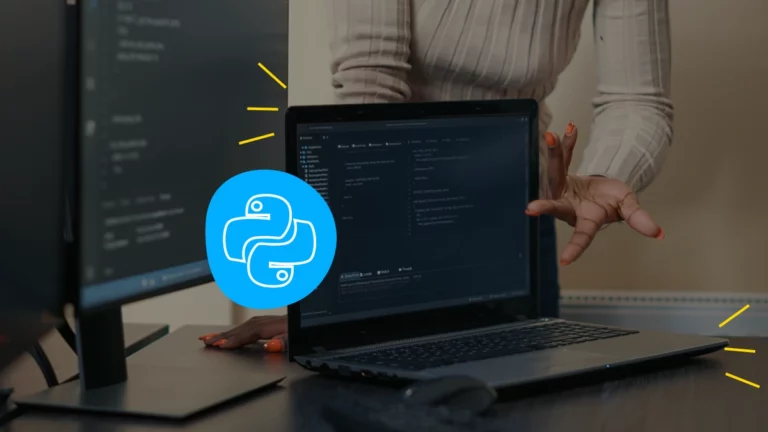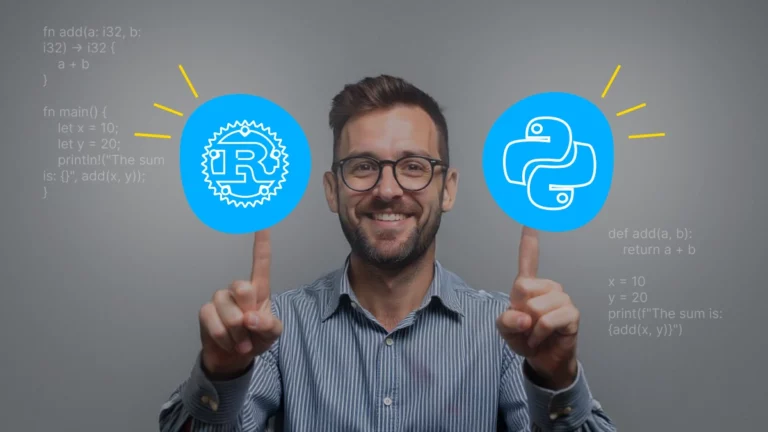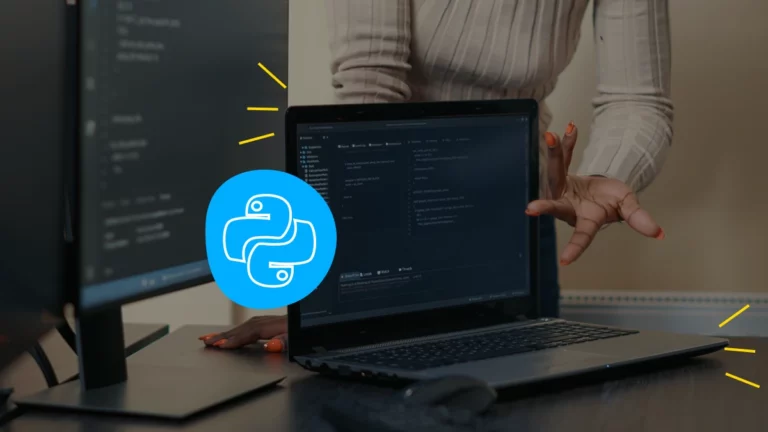R vs. Python: Differences, Strengths, and Uses in Data Science and Beyond
- Difference Between R and Python: Industry Demand and Job Market
- Foundational Characteristics of R and Python Code
- Python and R — Which Is Better? Unveiling Key Differences
- Python vs. R: Syntax and Ease of Learning Comparison
- Python versus R for Data Collection, Manipulation, and Analysis
- Difference Between Python and R in Data Visualization and Reporting
- Choosing The Right Language Based on Project Goals
- R or Python? Final Thoughts
- FAQs
With organizations increasingly relying on data-driven insights, the costs and risks of experimenting with new technologies have never been greater.
Machine learning, statistical analysis, data visualization, and bioinformatics — these domains frequently face the dilemma of choosing between R and Python. For such cases, the requirements for the tech stack are high: scalability, precision, advanced statistical modeling, deployment readiness, robust machine learning libraries for data processing, and specialized visualization tools are only some of them. So, which technology is better for these various cases?
With Mobilunity experts, we’ll guide you through the intricacies of the R versus Python selection, considering various factors: from language popularity and ease of use to IDEs and tooling options. So let’s explore key differentiators in detail.
Difference Between R and Python: Industry Demand and Job Market
By Developer Popularity
Python takes a leading position among the top programming languages, notably outperforming R in popularity due to its more versatile nature. Yet, even though R is less popular in usage, it has shown notable progress, rising from 20th in the previous year to its current rank — proving the dynamic growth of its developer community.
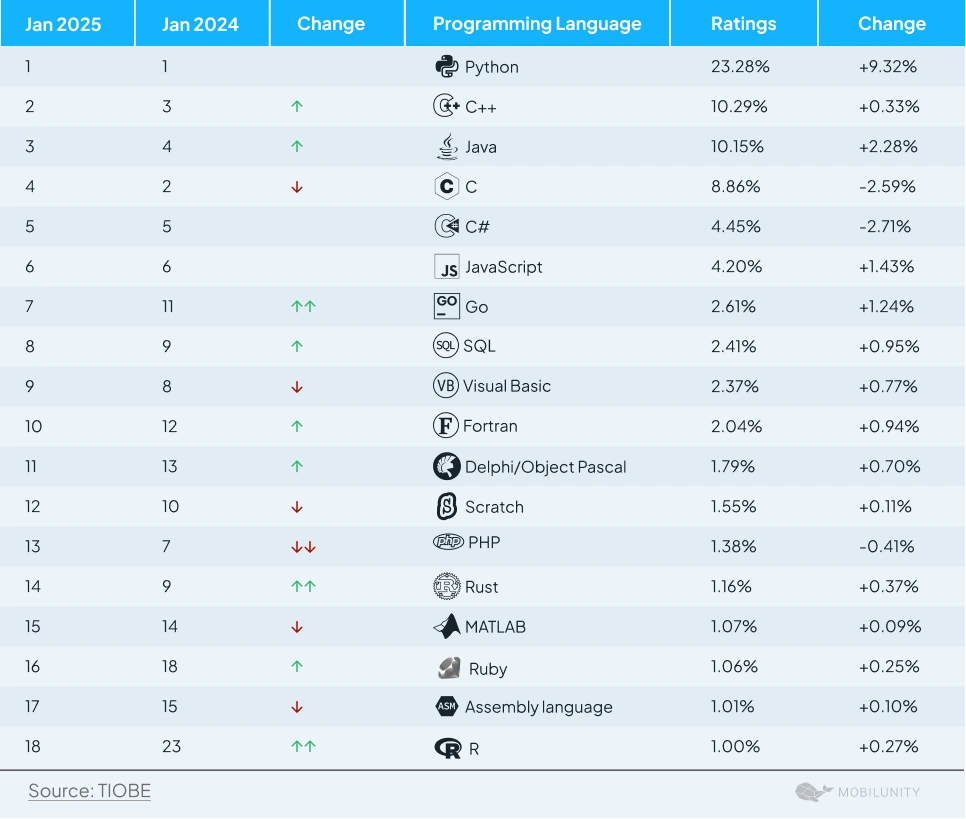
By Salary
Glassdoor reports state Python developers earn nearly double the average hourly rate of Rust developers. This pay can be explained by Python’s greater versatility and, in particular, demand in high-paying industries like data science and AI.
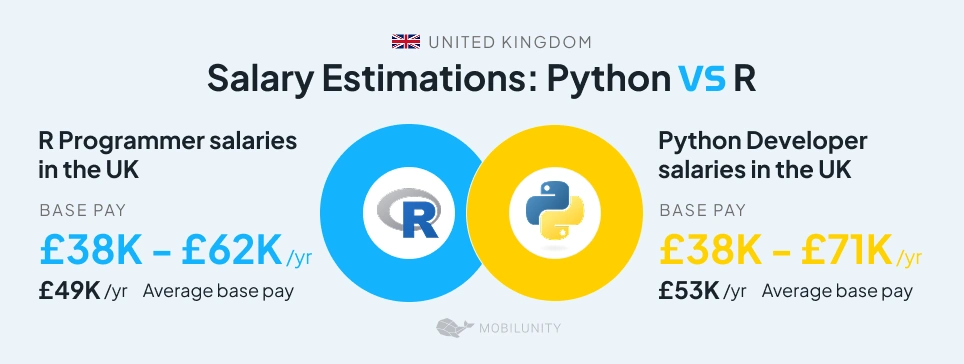
By Industry
According to GeeksforGeeks insights, Python and R are nearly equally used in financial services and corporate domains. That said, Python is reported to be more popular in telecom and consulting, while R dominates in retail and marketing sectors.
So why is this so that these languages win over these specific domains? Let’s take a closer look at their unique capabilities.
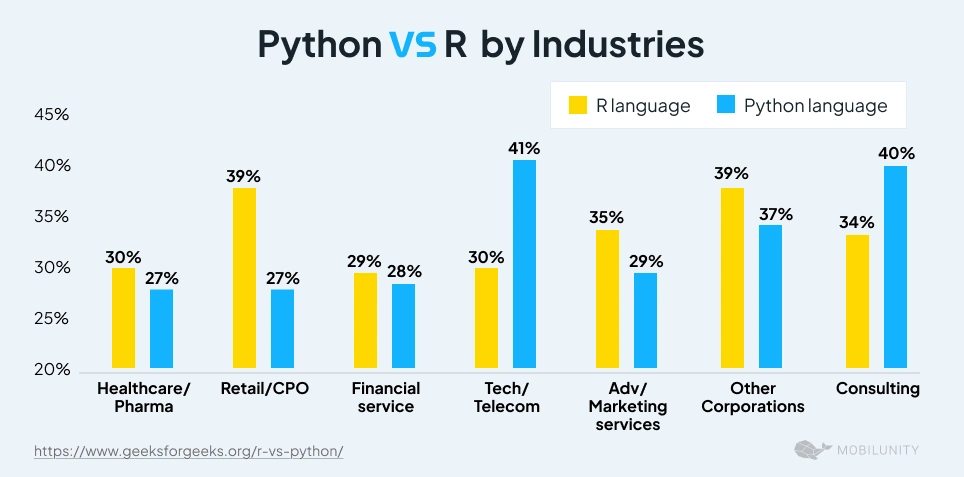
Foundational Characteristics of R and Python Code
What Is the Python Programming Language?
Python is a general-purpose programming language that was back in 1991 with the philosophy of prioritizing developer productivity and code readability.
Despite being several decades old, Python remains highly relevant today due to its versatility, simplicity, and adaptability to modern technological advancements. Besides, the community of Python fans praise its extensive library ecosystem able to address emerging fields like data science, machine learning, artificial intelligence, and cloud computing.
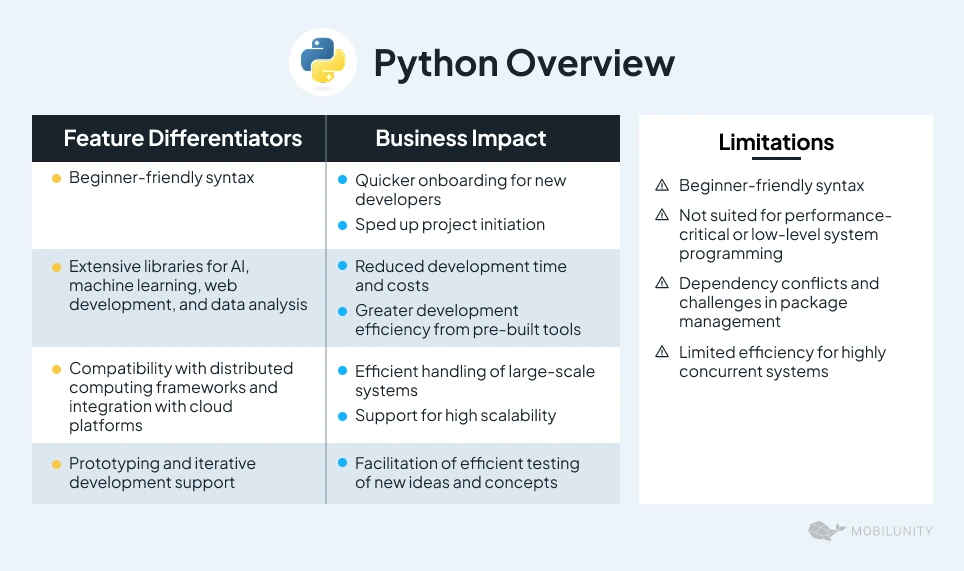
Python’s interpreted, dynamically typed nature enables flexibility and rapid prototyping. Its intuitive syntax closely resembles plain English, reducing the cognitive load for developers and enabling faster development cycles.
Despite its simplicity, Python is a powerful multi-paradigm language that supports object-oriented, procedural, and functional programming styles, giving developers the freedom to choose the approach that best suits their project. No wonder so many developers love using Python throughout a variety of projects.
What Is the R Programming Language?
R is a statistical software package designed as a specialized programming language for data analysis, visualization, and statistical computing. R was built in the early 1990s and rooted in the S programming language, with an emphasis on providing an open-source tool for data set processing and statistical modeling. With a running number of over 18,000 libraries available, this language boasts one of the most extensive ecosystems for statistical analysis and data visualization.
R’s nature as a domain-specific language for statistics allows it to handle complex analyses with ease. Exploratory data analysis, hypothesis testing, and predictive modeling — these and other data science-related tasks are the areas this language excels at. Besides, its functional programming capabilities and interactive environment make it highly efficient for prototyping and experimenting with data — making it a favorite among data analysts, statisticians, and researchers, to name a few.
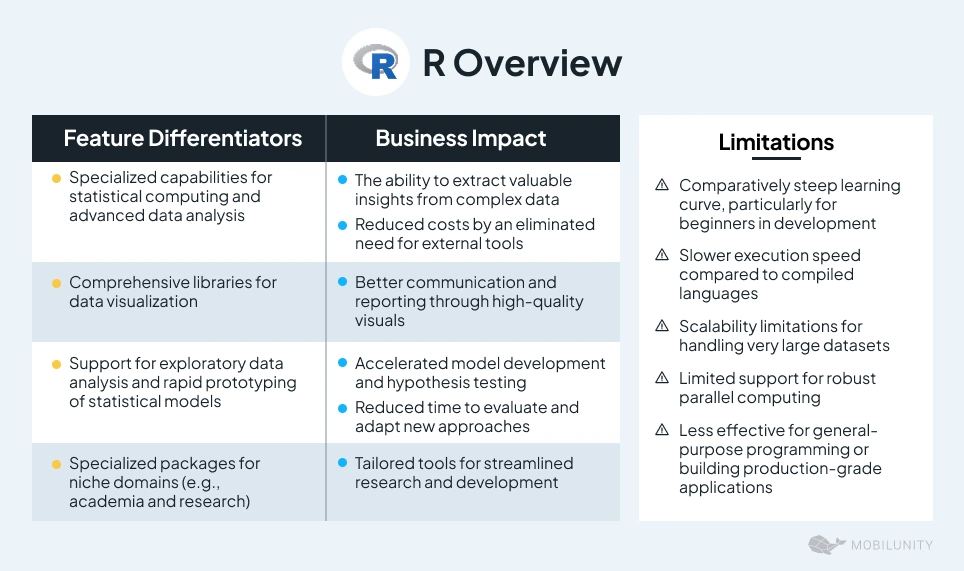
Python and R — Which Is Better? Unveiling Key Differences
While both are robust, these two languages serve different strengths. Consider these differences below when selecting your tech stack.
Performance
When it comes to performance — meaning, the efficiency of executing tasks in terms of speed, resource usage, and responsiveness — each of them excel in their specific areas.
Python scales well for large datasets with its suite of tools, while R excels with in-memory operations on small to medium datasets. Additionally, while Python and R might seem slower compared to low-level languages like C++ or Java, both can achieve impressive performance by leveraging optimized libraries, such as NumPy and Pandas for Python or data.table and Rcpp for R.
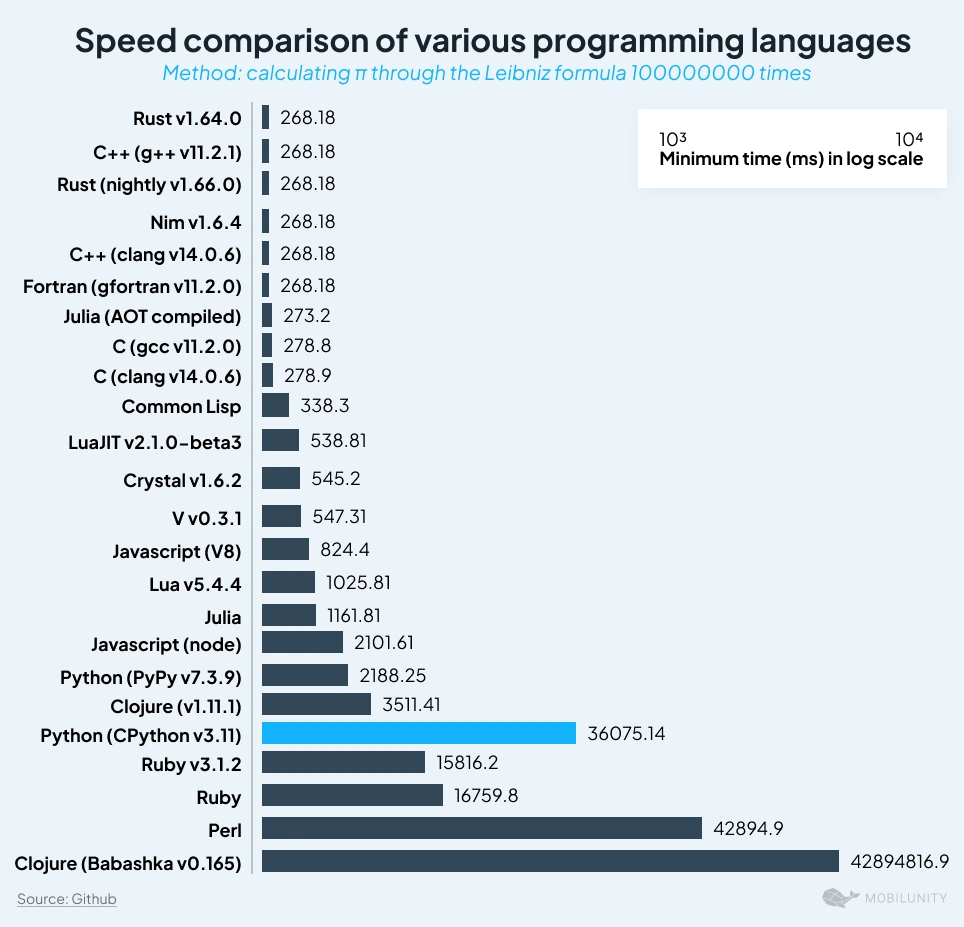
Scalability
The languages’ scalability, which implies the ability to handle growing workloads without losing efficiency, also varies between these two languages.
Python’s scalability allows it to handle everything from small scripts to large, enterprise-level systems — aided by frameworks like Django, Flask, and tools like Dask for distributed computing. In contrast, R is primarily suited for standalone complex data analysis, with its scalability limited to in-memory operations and requiring external frameworks to handle large-scale or distributed workloads effectively.
See more details about the scalability capabilities of both languages in the table below.
| Aspect | Python | R |
| Scalability for Big Data Processing | Efficient with Dask, PySpark, and Pandas | Limited to in-memory; needs tools like RHadoop or SparkR |
| Scalability in Distributed Computing | Supports Spark and Hadoop | Requires external tools like SparkR |
| Parallel Processing | Built-in via multiprocessing and Joblib | Relies on packages like parallel or foreach |
| Scaling Applications | Excellent with Flask, Django, and FastAPI | Limited production scalability |
| Cloud Integration | Strong with AWS, Google Cloud, and Azure | Needs third-party connectors |
Versatility and Application Areas
Python’s adaptability makes it well-suited for diverse applications. To illustrate this, Mobilunity gathered some of the most popular examples across various domains:
- Web development — including such popular examples as Instagram and YouTube backend;
- Data analysis — used in Netflix for analyzing and generating insights based on viewers’ activities;
- Artificial Intelligence — such as Tesla’s Autopilot system for machine learning algorithms;
- Game development — used by the Blender team for 3D animation.
While less versatile compared to Python, R is a preferred choice for tasks like complex statistical modeling, hypothesis testing, and biostatistical analysis. Hence, it is widely applied in the following fields and tasks:
- Financial modeling — as employed by ANZ Bank for risk assessment, credit scoring, and market predictions;
- Bioinformatics — applied by the Broad Institute for genomic studies and genome-wide association analyses;
- Academic research — utilized by Johns Hopkins University for clinical trial analysis and epidemiological studies;
Visualizing data — adopted by The New York Times to create high-quality visualizations for news articles.
Libraries and Ecosystem Support
Comparing Python and R, both languages have rich ecosystems with extensive libraries — each of them, however, caters to quite different priorities. Python’s libraries prioritize versatility and integration across domains, while R’s ecosystem is more geared toward statistical analysis. Explore the tech stack of each of them for various cases.
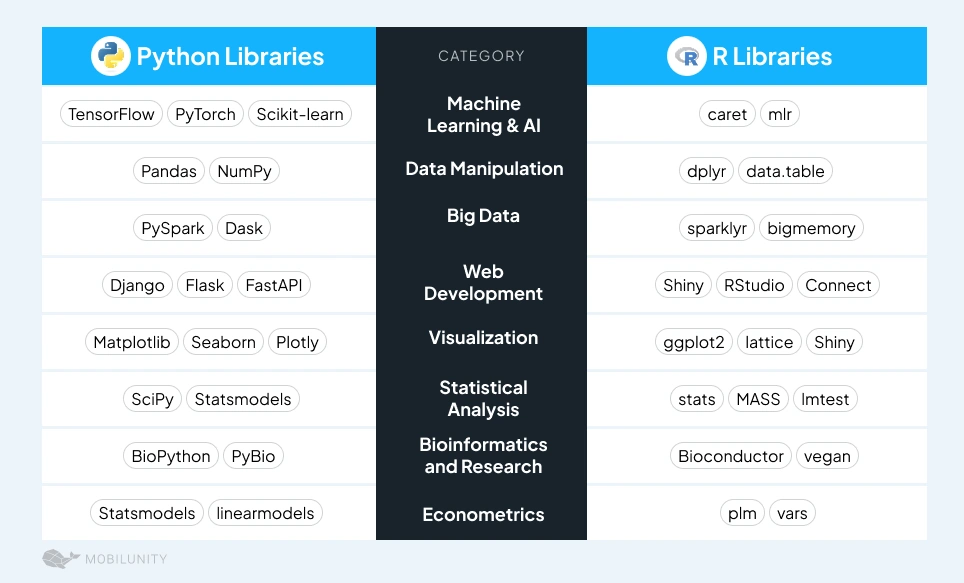
IDEs and Tooling Options
Speaking of IDEs and tooling options, both languages have them tailored to their respective strengths. Python provides versatile options like PyCharm for large-scale projects or Jupyter Notebook for beginner-friendly data science workflows, with strong debugging and integration capabilities for diverse applications such as AI, web development, and cloud services.
In contrast, while Python IDEs cater to a broader range of cases, R-focused tools focus specifically on enhancing R’s data-focused capabilities. Explore them in the table below.
| Feature | Python | R |
| Popular IDEs | PyCharm, VS Code, Jupyter Notebook | RStudio, RGUI, R Commander |
| Interactive Coding | Jupyter and Google Colab | RStudio’s built-in Notebook |
| Debugging Tools | pdb, PyCharm debugger | Integrated debugger in RStudio |
| Customization | Highly customizable IDE plugins | Limited to RStudio and a few plugins |
Python vs. R: Syntax and Ease of Learning Comparison
Python is considered easy to learn for beginners due to its simple and intuitive syntax, resembling natural language. R’s learning curve is comparatively steeper, especially for those without a background in statistics or programming. However, once mastered, both languages offer a robust set of capabilities to streamline development.
| Aspect | Python | R |
| Syntax | Clean, general-purpose, and readable | Statistical and analysis-focused syntax |
| Ease of Learning | Beginner-friendly for programming | Ideal for statisticians and researchers |
| Error Handling | Detailed error messages and debugging tools | Error messages can be less intuitive for programming beginners |
| Community Support | Wide community with resources in various domains | Strong support in statistical and research areas |
Choosing the Right Language
Based on the market research and internal expertise, Mobilunity experts recommend choosing Python in the following cases:
- For beginners in programming due to its intuitive, natural-language-like logic
- If working in fields beyond data science, such as web development, automation, or ML/A
- For integrating data-oriented tasks with broader software development workflows
Consider using R for:
- For specialists who require specialized statistical syntax
- When using pre-built statistical models and academic methodologies
- If the focus is on research and statistical visualization
To illustrate this example and explore the ease of learning of these two languages in action, let’s review the actual code examples.
When building web crawlers, Python offers clear and readable syntax, combined with scalable tools like Luigi and Requests, which makes it ideal for developing and maintaining large-scale crawlers. In the example below, the Python code leverages the Requests library to fetch the webpage content from a specified URL and BeautifulSoup to parse the HTML. It then extracts metadata and developer information from specific elements (div and p tags) and prints them, making web scraping simple and efficient.
In the meantime, the R-written code utilizes the rvest library to read the webpage content from a specified URL and parse the HTML. It identifies elements using CSS selectors (html_nodes and html_node), extracts metadata and developer information as text, and displays the results, but with more verbose syntax compared to Python.
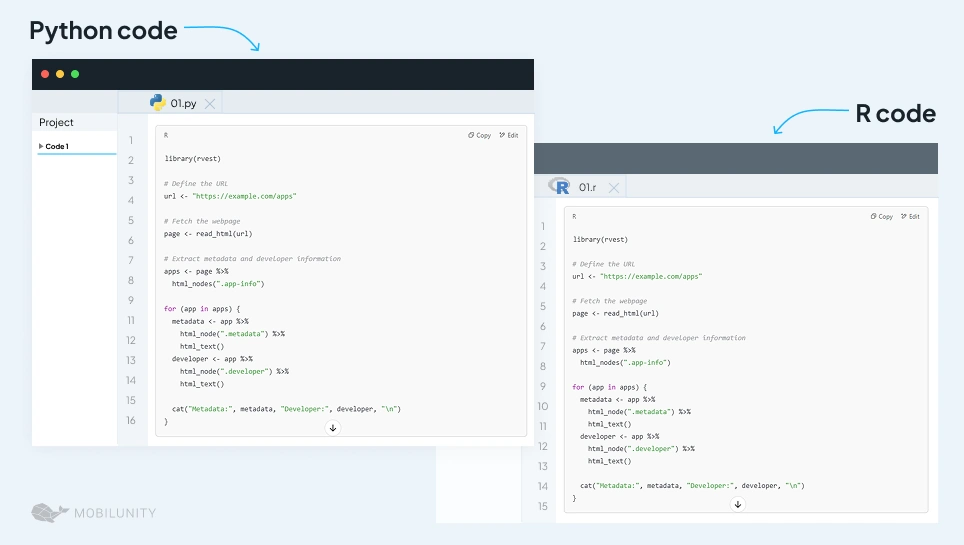
Python versus R for Data Collection, Manipulation, and Analysis
Both languages excel at data-focused tasks, but Python’s versatility makes it suitable for a broader range of projects, while R specializes in tabular data manipulation. While Python’s ecosystem of tools is more suitable for scalable and production-ready solutions, R’s frameworks are preferred for in-memory analysis and research-focused tasks. Explore the list of frameworks and libraries that support these capabilities.
| Feature | Python and its frameworks | R and its frameworks |
| Data Collection | Supports APIs, databases, CSV, JSON, and Excel with libraries like Pandas | Optimized for tabular data (CSV, Excel) and databases with RSQLite |
| Data Manipulation | Pandas excels in reshaping, filtering, and aggregating datasets | dplyr and data.table offer efficient syntax for group operations |
| Big Data Support | Scales well with Dask and Apache Spark | Less scalable for very large datasets without extensions like SparkR |
| Statistical Analysis | Requires external libraries (e.g., SciPy, Statsmodels) | Built-in and library-supported statistical analysis capabilities |
Choosing the Right Language for Data Collection Tasks
According to Mobilunity experts, Python can be preferred in the following scenarios:
- For handling distributed computing operations
- For scalable big data-related projects and machine learning pipelines
- When working with diverse data formats
In contrast, R can be best utilized as follows:
- When datasets are relatively small to medium-sized and structured
- For research-focused data processing
- When prioritizing in-memory processing
In the code example below, PySpark is leveraged for scalable data processing, starting with a SparkSession to handle distributed datasets. A Total column is calculated by multiplying Price and Quantity, and the data is grouped by Category to calculate totals. The processed data is visualized with Matplotlib, demonstrating Python’s strength in integrating distributed computing, maniulating data and visualizing advanced analytics.
In turn, the R code has dplyr for in-memory data manipulation and ggplot2 for visualization. It creates a data frame, calculates a Total column with mutate, and aggregates totals by Category using group_by and summarise. The results are visualized as a bar chart, showcasing R’s efficiency in concise, data-focused workflows for smaller datasets.
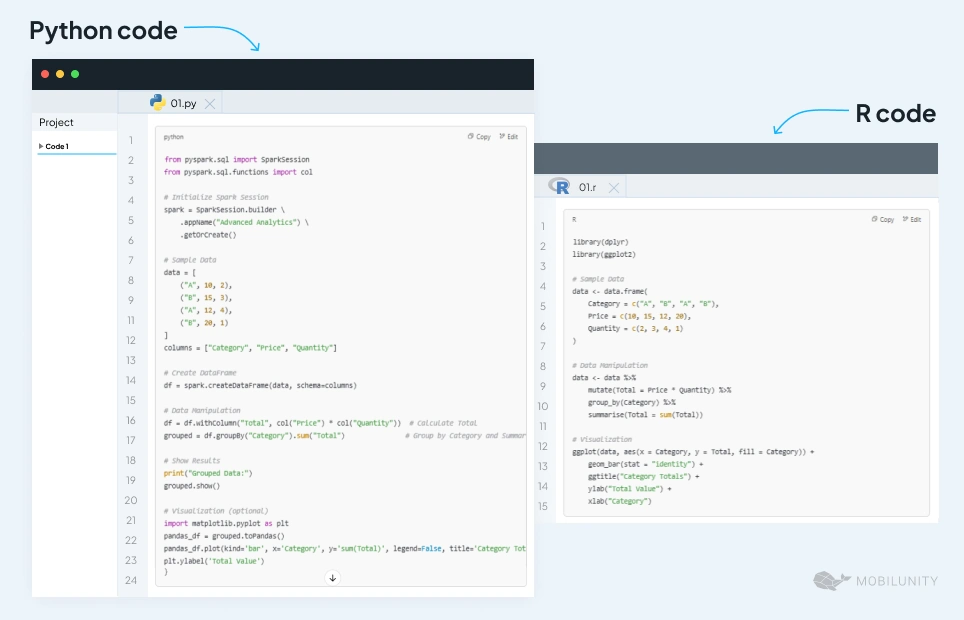
Python vs. R for Data Science and Modeling
Both languages excel in this domain — however, they serve different purposes. Python’s strength lies in its support for end-to-end pipelines, scalability, and automation. R also offers robust tools, but they are not as versatile. To further analyze these aspects, see the table below.
| Feature | Python | R |
| Machine Learning | Scikit-learn, TensorFlow, PyTorch | Limited ML libraries like caret and mlr |
| Statistical Models | Requires external libraries like Statsmodels | Built-in and library-supported models |
| Scalability | Integrates with large-volume data tools like Apache Spark | Less scalable without external extensions |
Selecting the Right-Fit Language
According to Mobilunity’s proven track record, Python can be chosen for:
- Building machine learning pipelines using libraries like Scikit-learn and TensorFlow
- Large-scale dataset processing with frameworks like Dask and PySpark
- Workflows requiring deep learning for analyzing images or text.
Meanwhile, R can be chosen for the following tasks:
- For in-depth data exploration with tools like ggplot2
- When datasets are small to medium-sized and fit in-memory
- For research requiring robust statistical methodologies and specialized models
The following code demonstrates how Python processes metadata for specific app package names stored in Amazon S3. Using boto3 for data retrieval, Pandas for manipulation, and Matplotlib for visualization, this code provides actionable insights, aligning perfectly with the use case of analyzing app metadata.
Similarly, R’s code showcases an alternative approach using readr, dplyr, and ggplot2 for similar tasks but optimized for smaller, in-memory datasets.
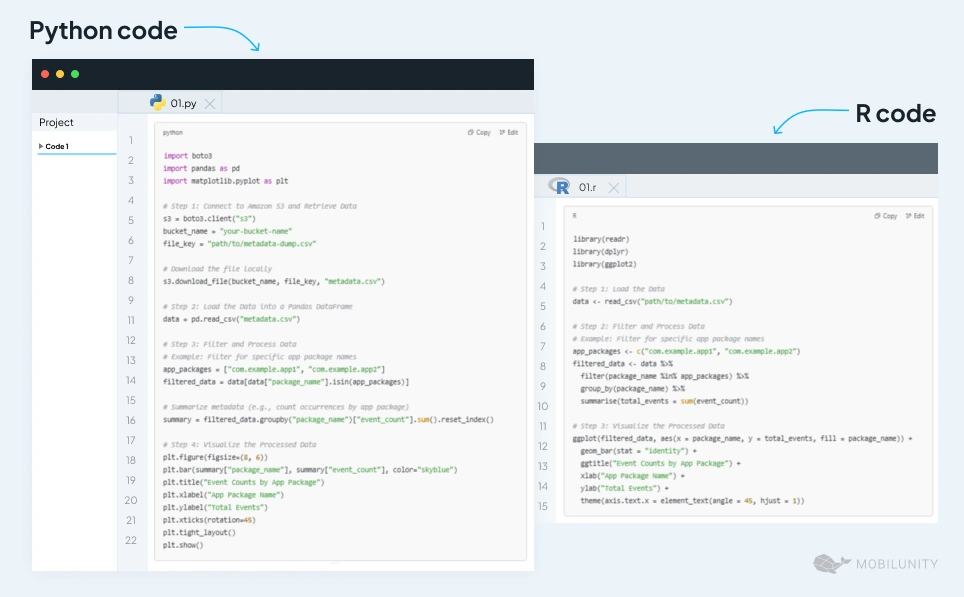
Difference Between Python and R in Data Visualization and Reporting
Both languages excel in this domain but serve different purposes. Python is more suitable for building interactive and web-based visual elements, while R stands out for its high-quality static graphics and ease of creating detailed reports from analyzing data.
| Feature | Python | R |
| Visualization | Matplotlib, Seaborn, Plotly | ggplot2, lattice, Shiny |
| Reporting | PDF/HTML reports via Jinja2 or LaTeX | Automated reports via RMarkdown |
| Interactivity | Dash, Bokeh for interactive plots | Shiny for interactive visualizations |
| Ease of Customization | Highly customizable for flexible designs | Simplifies customization for publication-quality graphics |
Choosing Between Python and R in Data Visualization
Based on common use cases, it is recommended to choose Python:
- For building interactive reports
- When integrating visual elements into web applications or dashboards
- For creating custom, script-based reports in a programmatic workflow
R, in turn, is well-suited for:
- Generating high-quality, static graphics for publications
- Conducting EDA with extensive visual components
- Producing detailed reports with automated workflows using packages like RMarkdown and Shiny
Using this example, in the Python for dashboard projects scenario Python demonstrates its ability to handle data visualization and dashboard creation by integrating data from multiple crawlers. The Python code uses Dash and Plotly to create a simple interactive dashboard. A dropdown lets users filter by Country, and a line chart dynamically updates to show filtered values over time. This demonstrates Python’s ability to build lightweight, interactive dashboards.
Likewise, the R-written code uses Shiny and ggplot2 to create an interactive dashboard. A dropdown allows filtering by Country, and a line chart updates dynamically based on the selection. This showcases R’s simplicity in building data-focused dashboards for smaller datasets.
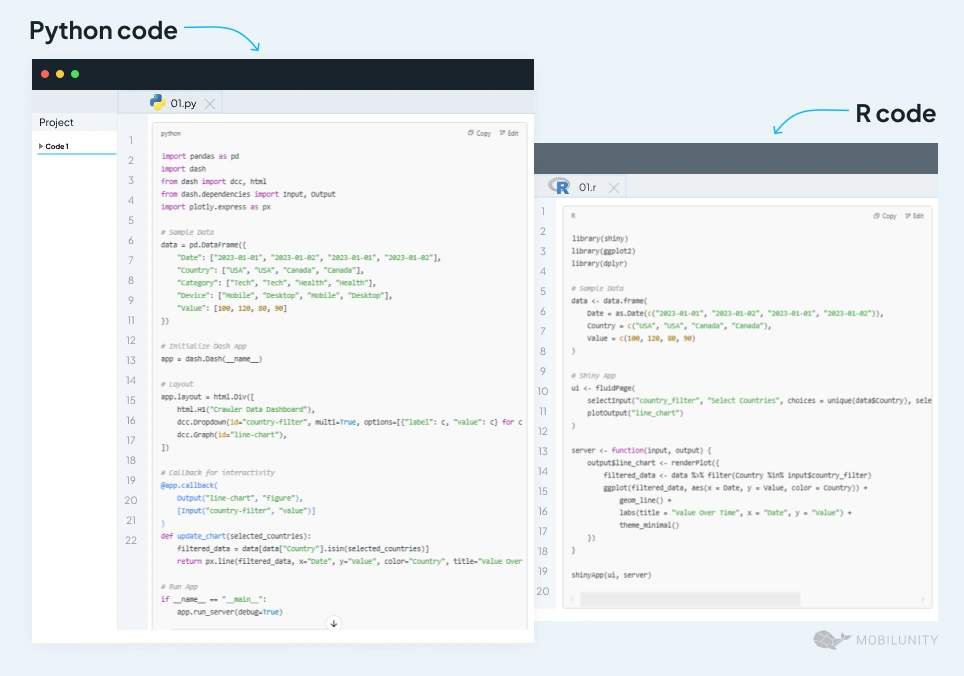
Choosing The Right Language Based on Project Goals
When starting a project, selecting the right programming language is crucial for ensuring success and efficiency. Whether you’re building web applications, analyzing data, or working on cutting-edge AI models, the right language can simplify development, enhance performance, and improve maintainability. Let’s review their core strengths for specific use cases.
| Project Type | Recommended Language | Why |
| AI-Powered Applications | Python | Robust libraries like TensorFlow, PyTorch, and Scikit-learn simplify machine learning and AI development. |
| Statistical Analysis | R | Built-in statistical functions and libraries like Statsmodels and caret make R a top choice. |
| Web Applications | Python | Frameworks like Django and Flask enable efficient web app development and integration. |
| Big Data Processing | Python | Integrates with tools like Apache Spark and Dask for distributed data workflows |
| Academic Research | R | Focused on reproducibility, with strong support for hypothesis testing and data modeling |
| Real-Time Analytics | Python | Flexible for building pipelines with libraries like Pandas and integrating with streaming tools |
| Data Dashboards | R | Tools like Shiny and ggplot2 create interactive, publication-quality dashboards |
| Data Pipelines for E-commerce | Python | Handles large-scale data processing and real-time analytics for customer behavior |
| Healthcare Data Visualization | R | Creates detailed, professional-grade visualizations for healthcare analytics |
| Automation Scripts | Python | Libraries like Selenium and Beautiful Soup streamline automation tasks |
| Scientific Simulations | R | Offers statistical tools tailored for scientific modeling and research workflows |
| Interactive e-Learning Tools | Python | Supports web-based applications and AI-driven personalized learning systems |
R or Python? Final Thoughts
As you can see, the unique Python’s and R’s strengths can be leveraged to achieve various project goals across diverse industry domains. By integrating the strengths of these two languages, organizations can optimize workflows, derive meaningful insights, and address complex challenges in fields such as healthcare, finance, marketing, and technology.
When choosing between R and Python, there are a number of aspects to consider from the project’s nature to your team’s expertise to integration and industry requirements. Also, evaluate scalability, ease of adoption, community support, and the availability of specialized libraries for your tasks. By addressing these aspects, you can ensure your chosen language maximizes project outcomes.

